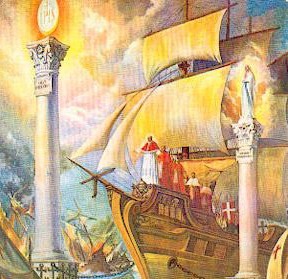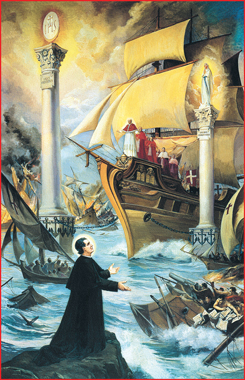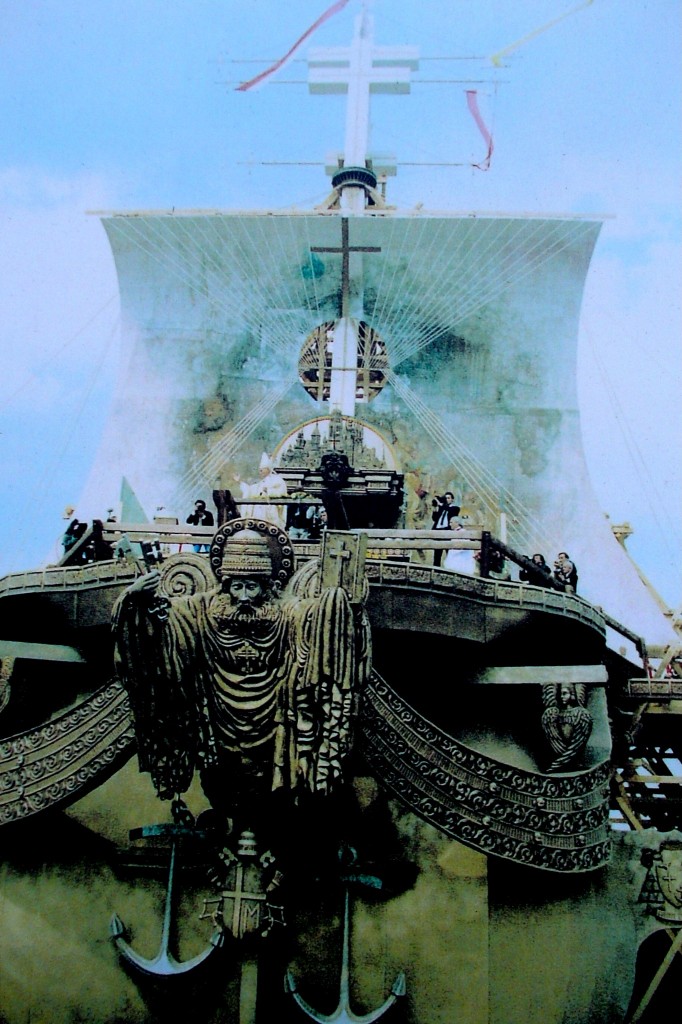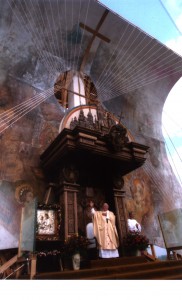Blessed Pope John Paul II and St. Don Bosco’s Dream of The Two Columns
 Most Catholics have heard about Saint Don Bosco and the order he founded based on the spirituality and charism of Saint Francis de Sales, today called the Salesians, which are divided up into Fathers, Brothers and Sisters. The idea of founding such a religious community within the Catholic Church was primarily to help young boys, and girls get an education during the industrial revolution of the late 19th Century.
Most Catholics have heard about Saint Don Bosco and the order he founded based on the spirituality and charism of Saint Francis de Sales, today called the Salesians, which are divided up into Fathers, Brothers and Sisters. The idea of founding such a religious community within the Catholic Church was primarily to help young boys, and girls get an education during the industrial revolution of the late 19th Century.
The Salesians’ charter describes the society’s mission as “the Christian perfection of its associates obtained by the exercise of spiritual and corporal works of charity towards the young, especially the poor, and the education of boys to the priesthood.” In 1845 Don Bosco opened a night school for boys in Valdocco which is now part of the City of Torino in Italy. Subsequently he opened many other schools for boys all over Italy and one of his most famous pupils was Saint Dominic Savio who died at the age of 15 and went straight to heaven. He was canonised on June 12th 1954 by venerable servant of God, His Holiness Pope Pius XII.
For over 60 years Don Bosco had a series of extraordinary “dreams” which contained clear visions of the future in a certain prophetic style. We are told that in his “Biographical Memoirs” how he used to relate those same “dreams” to his boys at night as a pep-talk before they went to bed. There were over 40 such dreams in all, mainly dealing with conflicts between good and evil, between the Church and Her Enemies and between Eternal Life and Damnation to hell.
One such “dream” is called “The Two Columns in the Sea.” We know from Saint John Bosco’s memoirs that on the 30th of May in 1862, he narrated this dream concerning the big battle, involving the Church and Her many adversaries, the sufferings of the Pope and the final triumph through devotion to the Most Holy Eucharist and to Our Blessed Mother, under the title “Help of Christians.” Little did Don Bosco know then that his vision would be fulfilled in exacting detail 125 years later.
In this particular dream Saint John Bosco saw himself standing on a rock in the middle of a vast ocean with no land in sight. What he saw was a vast fleet of innumerable ships in “battle array.” The prows of these ships were formed into sharp, spearlike points so that whenever they might be thrown or thrust they destroy completely. These enemy ships have lots of guns of all shapes and sizes and missiles but also books, which they also wish to use against one big ship, which Saint John Bosco sees as a majestic and fully equipped ship with its escorts of smaller ones and who receive commands by signals from the big ship. There are various movements and manoeuvres carried out by the escort ships to defend it.
 In the middle of this ocean and with chaos all around, Saint John Bosco sees “Two Columns in the Sea” one of which is smaller than the other, and on top of the smaller, stands a statue of the Blessed Virgin Mary. He explains that under Her feet, there is a written title which reads, “Auxilium Christianorum” which means in English, “Our Lady help of Christians” and on top of the taller Column is a huge host and written underneath that the title is written “Salus Credentium” which means that “Salvation of the Faithful” and which he indicates will be through the Eucharist.
In the middle of this ocean and with chaos all around, Saint John Bosco sees “Two Columns in the Sea” one of which is smaller than the other, and on top of the smaller, stands a statue of the Blessed Virgin Mary. He explains that under Her feet, there is a written title which reads, “Auxilium Christianorum” which means in English, “Our Lady help of Christians” and on top of the taller Column is a huge host and written underneath that the title is written “Salus Credentium” which means that “Salvation of the Faithful” and which he indicates will be through the Eucharist.
On the deck of the big majestic ship, Saint John Bosco sees the unnamed Sovereign Pontiff who summons all his power and energies to guide the big ship in between the “Two Columns in the Sea.” He also points out that there are two very big anchors on the Ship one on either side, which are now attached to the Two Columns in the Sea as though the big ship was seeking safety in the midst of the violent storm which was raging against Her. All of the enemy ships move to attack the big ship using guns, writings, books and shouting and anything else they can find. The enemies use all their power and might as violently as they can to try to sink the big ship, but no matter what happens, gentle breezes from the “Two Columns in the Sea” protect, and save the big ship from destruction.
All the ships that have fought against the Pope’s big ship are scattered, they flee, they collide, break up and are lost. Those smaller ships that have come to the Pope’s rescue and have helped save the big ship are now tied up to the Two Columns in the Sea. They are safe from the raging wind and fire and storms that are sinking the enemy ships.
For Saint John Bosco, the Captain of the big majestic ship is the Pope himself, and the big ship itself is the Catholic Church. The Two Columns in the Sea are also important in this vision. The smaller Column is a Marian Colum, and if we are connected to it we will be safe. To be tied up to it, means security in the midst of all the storms that rage around us as individuals, and if we are anchored to Her then She will be anchored to us. The title of this Marian Column in the Sea is “Our Lady Help of Christians.”This title was important to Pope John Paul II, because his consecration to Our Lady was precisely to Her under this title.
Pope John Paul II declared 1987-1988 a Marian Year, that is a year dedicated to Our Lady. We know how much he was dedicated to Our Lady, but to Her under which title? His “Totus Tuus,” or consecration to Our Lady, which becomes his pontifical motif, comes from Saint Louis De Montfort’s “True Devotion to Mary,” and that prayer of consecration is to Our Lady Help of Christians “Auxilium Christianorum.” When the Pope was a young boy he used to pray at Saint Florins church in Krakow, and it is in this church that there is a Marian shrine of Our Lady Help of Christians. Here is where he made the consecration, and here in this church was he to serve as parish priest 20 years later on the road to the Papacy.
In 1987-1988 we had the second Marian Year in the history of the Church, the first having been proclaimed by Pope Pius XII in 1954, on the 100th anniversary of the proclamation of the Dogma of the Immaculate Conception. In the year 2004, Pope John Paul II declared that year the “Year of the Eucharist.” The Eucharist was represented by the larger Column in the Sea, under the large Host on top of the Column was written in gold, the title “Salvation of the Faithful” on unto this Column the Church was also tied. Therefore we can now see that the Church needs both the Eucharist and Our Lady to survive all the attacks that are levelled against it. If the Church is anchored to these two things, She will never fail in Her mission.
This vision also had many ships that were the enemies of the Church. We can understand today that these were Soviet Countries and their allies. The Soviets were atheists and hated the Church, ultimately they hated God. They wanted to spread their errors worldwide and have dominion of the entire world; it was only the Catholic Church’s existence that stood in its way. The Polish Pope was an even bigger problem for them, for he knew how to destroy them: with moral authority and prayer. He even gave moral support to the Polish trade union movement Solidarity. The Pope also was familiar with Marxist Doctrine and its concrete applications. He didn’t believe that the Communist system was capable of evolution. He also didn’t believe that there could be such a thing as communism with “a human face” because Marxism takes away man’s freedom, and so limits his ability to act and develop. On top of that, Marxist ideology claimed that religion is “the opium of the people” so it engaged in propaganda (books) on behalf of Atheism and didn’t recognise the freedom of conscience or of religious bodies. Therefore it is hard to reconcile the position of the Church with Marxism and Communism and the communists knew that, so they wanted to destroy the Church.
From the Marian year then, until the Year of the Eucharist, the world witnessed the collapse of the Soviet Empire and with it all attempts to destroy the Church. That is from 1987 to 2004, a total of 17 years, evil was defeated by the triumph of the Eucharist, Our Lady and Pope John John Paul II, the Great. The Berlin Wall came down in 1989 and that started the unstoppable domino effect. The cry for freedom was then heard in all Soviet Countries. There were names of countries — some of which had never been heard before — emerging, beautiful names: Russia, Poland, Latvia, Estonia, Hungry, etc.
The Pope suffered an attempted assasination — now believed to have been a Soviet- inspired plot — on May 13, 1981, and he should have died, by all accounts; he himself believed to his dying day that it was Our Lady Help of Christians who saved him. In meeting his assassin Mehmet Ali Agca in prison afterwards, the Pope asked him who had ordered the killing, but he was never told. Instead Ali Agca asked him “Why aren’t you dead” and this question was asked repeatedly and in addition he added “I know I was aiming right, I know that the bullet was a killer, so why aren’t you dead?” He never asked for forgiveness, but the Holy Father forgave him anyway.
 What Saint John Bosco saw in this, one of his 40 “prophetic dreams,” has come to past and it was Pope John Paul II who fulfilled this dream. The Pope did not realize that when he went to Poland in 1987, to the Gdansk shipyard to support the rights of workers, to preach about true freedom, the rights of the Church to exist, and to proclaim the Gospel about Jesus Christ, that he would be standing on a “big ship” — but that is is exactly what he did.
What Saint John Bosco saw in this, one of his 40 “prophetic dreams,” has come to past and it was Pope John Paul II who fulfilled this dream. The Pope did not realize that when he went to Poland in 1987, to the Gdansk shipyard to support the rights of workers, to preach about true freedom, the rights of the Church to exist, and to proclaim the Gospel about Jesus Christ, that he would be standing on a “big ship” — but that is is exactly what he did.
The shipyard workers built a huge sailing ship as an altar and along with it anchors and sails. The Pope stands at the front of the “big ship” which not only has the statue of Saint Peter with the Keys, but has two anchors just as the vision of Saint John Bosco foretold. The other very strange thing about the vision of 1862 was that the big ship which had the Pontiff at the front was a sailing ship. We see that same sailing ship with the Pope at the head, guiding the Church, but here he was in Gdansk, in Poland with the Baltic Sea behind him.
Gdansk had become the epicentre of the conflict between good and evil, Here in Westerplatte, Nazi guns fired for the first time against Poland, starting the Second World War. Here in Gdansk, the first city captured by the Soviets, the seeds of freedom were coming from the “Lenin” shipyards through the Solidarity movement. The movement was born from the inspiration of Pope John Paul II and came about when the people, who were individually powerless, stood together in strength — solidarity. Poland and the world itself were threatened with nuclear annihilation by the Soviet Empire, but the world was saved at this time.
 Today, Poland and the world are at peace and Gdansk sits at the opening of the great “Baltic Sea.” The Church in Poland is strong and there are many vocations to the priesthood and the religious life and to lay apostolates. Pope John Paul II has truly inspired Poland and all of Europe and he has guided the Church on the right path which will lead the faithful to Paradise through devotion to Our Blessed Lady, “Help of Christians” and to devotion to and frequent reception of the Holy Eucharist. Pope John Paul II, the Great, was a gift to the world from heaven, having enjoyed the very special protection of Our Lady of the Rosary at Fatima. Once the Holy Father had read the message of Fatima in the Gemelli Hospital in Rome, the so called third part of the secret, all doubts were gone, he knew this secret was about himself. He was convinced that his life was saved by Our Lady — no given back to him anew, thanks to Our Lady’s intervention and protection.
Today, Poland and the world are at peace and Gdansk sits at the opening of the great “Baltic Sea.” The Church in Poland is strong and there are many vocations to the priesthood and the religious life and to lay apostolates. Pope John Paul II has truly inspired Poland and all of Europe and he has guided the Church on the right path which will lead the faithful to Paradise through devotion to Our Blessed Lady, “Help of Christians” and to devotion to and frequent reception of the Holy Eucharist. Pope John Paul II, the Great, was a gift to the world from heaven, having enjoyed the very special protection of Our Lady of the Rosary at Fatima. Once the Holy Father had read the message of Fatima in the Gemelli Hospital in Rome, the so called third part of the secret, all doubts were gone, he knew this secret was about himself. He was convinced that his life was saved by Our Lady — no given back to him anew, thanks to Our Lady’s intervention and protection.
Pope John Paul II was prefigured by Saint John Bosco in 1864 as the Pope on the helm of the Ship, which was the Church, and he was also foreseen by Sister Lucy Dos Santos of Fatima in 1917, three years before he was born. Sister Lucy as she was later known became a discalced Carmelite Nun and she tells us all about this Pope in her book Calls. She also revealed to him the secrets of Fatima of which he was the one spoken of. It was Pope John Paul II who fulfilled the prophecies, given by Our Lady in 1917 at the outset of the Bolshevik Revolution of October 1917. Our Lady saw its beginning and she foretold who would end it.
Sister Lucy was given that very special and secret mission by Our Lady of the Rosary to pray for the protection of Pope John Paul II and for his Ministry as the successor of Peter, the Pope of the Millennium, the one who would guide the Church through its most difficult times when the Church was at its most vulnerable, after two successive world wars. Our Lady of Fatima asked in 1917 that Russia would be consecrated to Her Immaculate Heart and following that, there would be peace.
Pope John Paul was the Pope to carry out this task on a universal level. (Pope Pius XII did consecrate the World to the Immaculate Heart of Mary, but not in union with all the bishops of the world at the same time, which was what Our Lady had requested.) Truly Pope John Paul II, the prefigured and foreseen Pope, the 3rd longest reigning Pontiff in the History of the Church has set the Church on a profound path in his Apostolic Letter Novo Millennio Ineunte. He has in fact laid the tracks on which the Church will follow to the end of time.
Venerable Pope John Paul II, the Great was truly a gift to the world, foreseen by Saint John Bosco and foreseen by Sister Lucy and Blessed Francisco and Blessed Jacinta Marto. He was the Pope who saved the world, through the power of the Eucharist and the prayers of Our Lady; he guided the Church through its most turbulent times in its history. His life-long friend Cardinal Andrej Maria Deskur who died on the 7th of September of this year said that Pope John Paul II lived in prayer, because he had from his time in the seminary received a very special gift of infused prayer with apparitions, or inner words. May this great saint now in heaven pray for the unity of the Church, East and West, so that it will once again breathe with “two lungs” and reinvigorated anew, may this stronger Church, guided by the Holy Spirit renew the face of the earth and banish from it the forces of evil.

